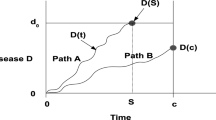Abstract
In the development of many diseases there are often associated variables which continuously measure the progress of an individual towards the final expression of the disease (failure). Such variables are stochastic processes, here called marker processes, and, at a given point in time, they may provide information about the current hazard and subsequently on the remaining time to failure. Here we consider a simple additive model for the relationship between the hazard function at time t and the history of the marker process up until time t. We develop some basic calculations based on this model. Interest is focused on statistical applications for markers related to estimation of the survival distribution of time to failure, including (i) the use of markers as surrogate responses for failure with censored data, and (ii) the use of markers as predictors of the time elapsed since onset of a survival process in prevalent individuals. Particular attention is directed to potential gains in efficiency incurred by using marker process information.
Similar content being viewed by others
References
M. Abramowitz and I. A. Stegun, (Eds.), Handbook of Mathematical Functions, Dover: New York, 1965.
M. S. A-Hameed and F. Proschan, “Shock models with underlying birth processes,” Journal of Applied Probability vol. 12, pp. 18–28, 1975.
S. M. Berman, “A stochastic model for the distribution of HIV latency time based on T4 counts,” Biometrika vol. 77, pp. 733–741, 1990.
R. Brookmeyer and M. Gail, “Biases in prevalent cohorts,” Biometrics vol. 43, pp. 739–749, 1987.
D. R. Cox, “Regression problems and life tables (with discussion),” J. R. Statist. Soc. B vol. 34, pp. 187–220. 1972.
D. R. Cox, “A remark on censoring and surrogate response variables,” J. R. Statist. Soc. B vol. 45, pp. 319–393, 1983.
A. Dewanji and J. D. Kalbfleisch, “Nonparametric methods for survival/sacrifice experiments,” Biometrics vol. 42, pp. 325–341, 1986.
B. Efron, “Efficiency of Cox's likelihood function for censored data,” J. Amer. Statist. Assoc. vol. 72, pp. 557–565, 1977.
J. D. Esary, A. W. Marshall and F. Proschan, “Shock models and wear processes,” J. Annals of Probability vol. 1, pp. 627–649, 1973.
R. E. Fusaro, J. P. Nielsen and T. H. Scheike, “Marker-dependent hazard estimation: an application to AIDS,” Statistics in Medicine, vol. 12, pp. 843–865, 1993.
N. P. Jewell and J. D. Kalbfleisch, “Marker processes in survival analysis.” University of California Biostatistics Technical Report #24, 1991.
N. P. Jewell and J. D. Kalbfleisch, “Marker processes and applications to AIDS,” In AIDS Epidemiology: Methodological Issues, N. P. Jewell, K. Dietz and V. Farewell, eds., Birkhauser: Boston, 1992.
N. P. Jewell and J. P. Nielsen, “A framework for consistent prediction rules based on markers,” Biometrika vol. 80, pp. 153–164, 1993.
J. D. Kalbfleisch and R. L. Prentice, The Statistical Analysis of Failure Time Data, Wiley: New York, 1980.
H. M. Malani, “A modification of the redistribution to the right algorithm using disease markers,” Biometrika vol. 82, pp. 515–526, 1995.
B. McKnight and J. Crowley, “Tests for differences in tumor incidence based on animal carcinogenesis experiments,” J. Amer. Statist. Assoc. vol. 79, pp. 639–648, 1984.
A. Munõz M.-C. Wang, S. Bass, J. M. G. Taylor, L. A. Kingsley, J. S. Chmiel, B. F. Polk and the Multicenter AIDS Cohort Study Group, “Acquired immunodeficiency syndrome (AIDS)-free time after human immunodeficiency virus type 1 (HIV-1) seroconversion in homosexual men,” American Journal of Epidemiology vol. 130, pp. 530–539, 1989.
R. L. Prentice, “Surrogate endpoints in clinical trials: definition and operational criteria,” Statistics in Medicine vol 8. pp. 431–440, 1989.
P. S. Puri, “A class of stochastic models of response after infection in the absence of defense mechanism,” Proceedings of the Fifth Berkeley Symposium on Mathematical Statistics and Probability, Berkeley and Los Angeles, University of California Press, vol. 4, pp. 511–536, 1966.
J. M. Robins and A. Rotnitzky, “Recovery of information and adjustment for dependent censoring using surrogate markers,” In AIDS Epidemiology: Methodological Issues, N. P. Jewell, K. Dietz, and V. Farewell, eds., Birkhauser: Boston, 1992.
E. B. Rockower, “Reliability in a random environment.” Naval Postgraduate School Technical Report, Monterey, California, #NPS55-86-018, 1986.
A. Segall and T. Kailath, “The modeling of randomly modulated jump processes,” IEEE Transactions on Information Theory IT 21, pp. 135–143, 1975.
M. Shi, J. M. G. Taylor, and A. Munõz “Models for residual time to AIDS,” Lifetime Data Analysis vol. 2, 1996.
J. M. G. Taylor, A. Munõz, S. M. Bass, A. J. Saah, J. S. Chmiel, L. A. Kingsley, and the Multicentre AIDS Cohort Study, “Estimating the distribution of times from HIV seroconversion to AIDS using multiple imputation,” Statistics in Medicine vol. 9, pp. 505–514, 1990.
Author information
Authors and Affiliations
Rights and permissions
About this article
Cite this article
Jewell, N.P., Kalbfleisch, J.D. Marker processes in survival analysis. Lifetime Data Anal 2, 15–29 (1996). https://doi.org/10.1007/BF00128468
Received:
Accepted:
Issue Date:
DOI: https://doi.org/10.1007/BF00128468




